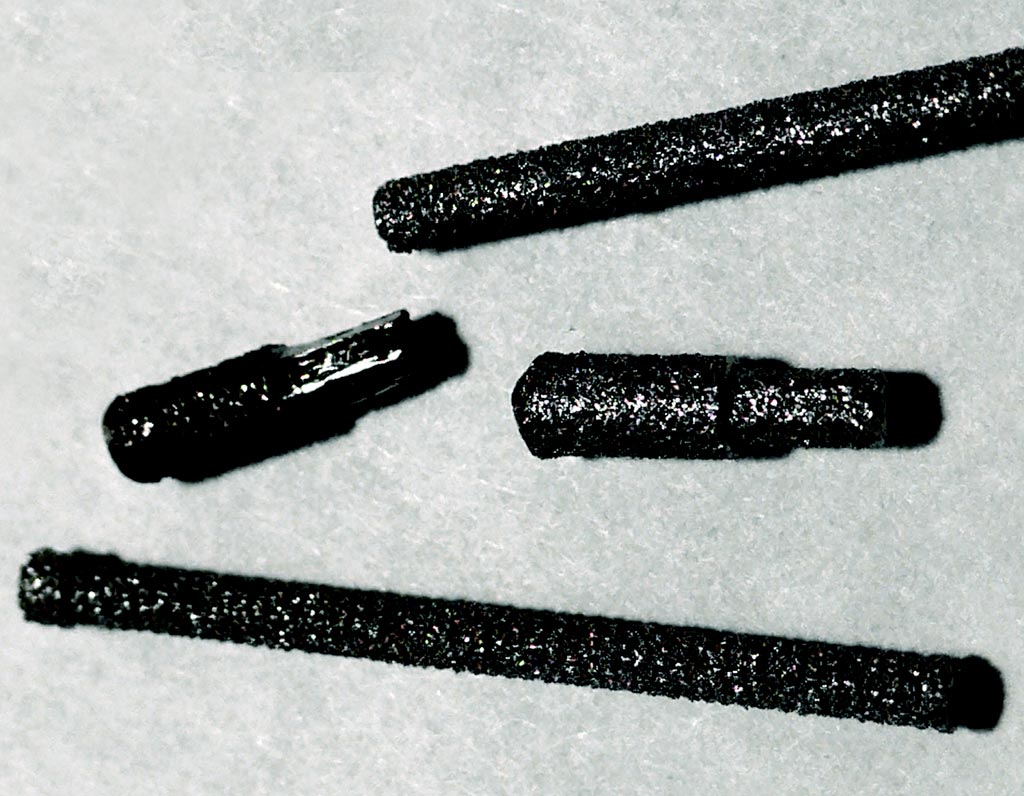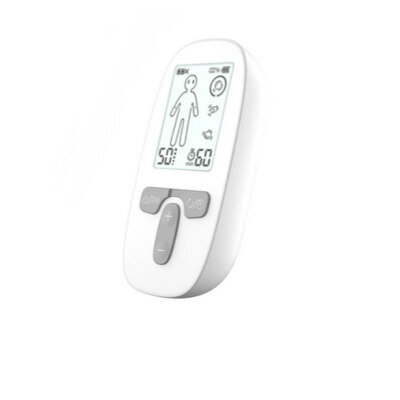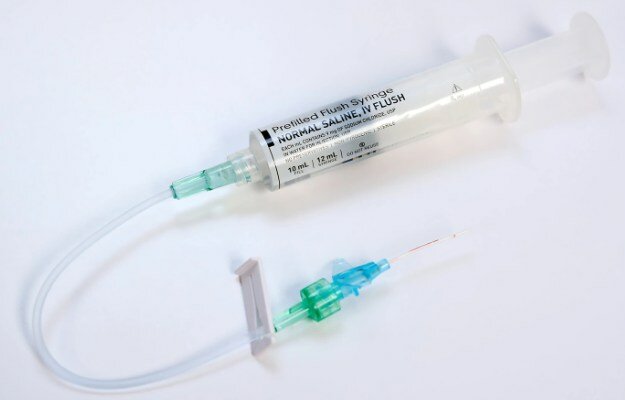3D-Printed Implants Improve Amputee Prosthetics Integration
|
By HospiMedica International staff writers Posted on 10 Jul 2017 |

Image: A new study shows additive manufacturing 3D printing technologies can be used to produce transcutaneous osseointegrated prostheses (Photo courtesy of UNC).
A new study shows that three dimensional (3D) additive manufacturing (AM) printing technologies can be used to customize implant surface textures and geometries to match the specific anatomy of human amputees.
Researchers at the University of North Carolina (UNC, Chapel Hill, USA) and North Carolina State University (NC State, Raleigh, USA) conducted a study to evaluate electron beam melting (EBM) and direct metal laser sintering (DMLS) for the manufacture of titanium osseointegrated implants. While EBM produces only a coarse textured implant, DMLS can create either a fine or coarse textured surface. For the study, two cohorts of Sprague-Dawley rats received bilateral titanium implants in their distal femurs, and were followed for four weeks.
The first cohort animals received EBM implants transcortically in one femur and a DMLS implant in the contralateral femur. The second cohort received DMLS implants (either fine textured or coarse textured in order to mimic EBM) in the intramedullary canal of each femur. The researchers then compared the two AM methods and the resulting strength of bone integration, interlocking, and torque. The results showed substantial differences between the two methods, including osseointegration and torsional properties, bone volume fraction (BV/TV), and bone-implant contact (BIC).
The researchers found that fixation strength of coarse textured implants provided superior interlocking, relative to fine textured implants, without affecting BV/TV or BIC in both rat cohorts. The coarse EBM implants in the transcortical model demonstrated an 85% increase in removal torque relative to the fine DMLS textured implants. On the other hand, the thrust load in the intramedullary model saw a 35% increase from fine to coarse DMLS implants. The study was published in the June 2017 issue of 3D Printing and Additive Manufacturing.
“Osseointegrated implants transfer loads from native bone to a synthetic joint and can also function transdermally to provide a stable connection between the skeleton and the prostheses, eliminating many problems associated with socket prostheses,” concluded senior author Paul Weinhold, PhD, of UNC, and colleagues. “Additive manufacturing provides a cost-effective means to create patient-specific implants, and allows for customized textures for integration with bone and other tissues. Due to spatial resolution, DMLS can produce surfaces with a roughness comparable to EBM.”
Direct transcutaneous osseointegrated prostheses constitute an emerging alternative to traditional socket prostheses that offer a stable connection, and the elimination of dermal lesions caused by the socket-skin interface. Osseointegrated implants also transfer loads from the residual native bone to a synthetic joint and back to the opposing bone in total joint replacements. AM implants provide a cost-effective means to customize the shape of the implant to interface with a patient's unique bone morphology, and allow for the customization of the surface texture that integrates directly with the bone and other tissues.
Related Links:
University of North Carolina
North Carolina State University
Researchers at the University of North Carolina (UNC, Chapel Hill, USA) and North Carolina State University (NC State, Raleigh, USA) conducted a study to evaluate electron beam melting (EBM) and direct metal laser sintering (DMLS) for the manufacture of titanium osseointegrated implants. While EBM produces only a coarse textured implant, DMLS can create either a fine or coarse textured surface. For the study, two cohorts of Sprague-Dawley rats received bilateral titanium implants in their distal femurs, and were followed for four weeks.
The first cohort animals received EBM implants transcortically in one femur and a DMLS implant in the contralateral femur. The second cohort received DMLS implants (either fine textured or coarse textured in order to mimic EBM) in the intramedullary canal of each femur. The researchers then compared the two AM methods and the resulting strength of bone integration, interlocking, and torque. The results showed substantial differences between the two methods, including osseointegration and torsional properties, bone volume fraction (BV/TV), and bone-implant contact (BIC).
The researchers found that fixation strength of coarse textured implants provided superior interlocking, relative to fine textured implants, without affecting BV/TV or BIC in both rat cohorts. The coarse EBM implants in the transcortical model demonstrated an 85% increase in removal torque relative to the fine DMLS textured implants. On the other hand, the thrust load in the intramedullary model saw a 35% increase from fine to coarse DMLS implants. The study was published in the June 2017 issue of 3D Printing and Additive Manufacturing.
“Osseointegrated implants transfer loads from native bone to a synthetic joint and can also function transdermally to provide a stable connection between the skeleton and the prostheses, eliminating many problems associated with socket prostheses,” concluded senior author Paul Weinhold, PhD, of UNC, and colleagues. “Additive manufacturing provides a cost-effective means to create patient-specific implants, and allows for customized textures for integration with bone and other tissues. Due to spatial resolution, DMLS can produce surfaces with a roughness comparable to EBM.”
Direct transcutaneous osseointegrated prostheses constitute an emerging alternative to traditional socket prostheses that offer a stable connection, and the elimination of dermal lesions caused by the socket-skin interface. Osseointegrated implants also transfer loads from the residual native bone to a synthetic joint and back to the opposing bone in total joint replacements. AM implants provide a cost-effective means to customize the shape of the implant to interface with a patient's unique bone morphology, and allow for the customization of the surface texture that integrates directly with the bone and other tissues.
Related Links:
University of North Carolina
North Carolina State University
Latest Surgical Techniques News
- Robotic Assistant Delivers Ultra-Precision Injections with Rapid Setup Times
- Minimally Invasive Endoscopic Surgery Improves Severe Stroke Outcomes
- Novel Glue Prevents Complications After Breast Cancer Surgery
- Breakthrough Brain Implant Enables Safer and More Precise Drug Delivery
- Bioadhesive Sponge Stops Uncontrolled Internal Bleeding During Surgery
- Revolutionary Nano Bone Material to Accelerate Surgery and Healing
- Superior Orthopedic Implants Combat Infections and Quicken Healing After Surgery
- Laser-Based Technique Eliminates Pancreatic Tumors While Protecting Healthy Tissue
- Surgical Treatment of Severe Carotid Artery Stenosis Benefits Blood-Brain Barrier
- Revolutionary Reusable Duodenoscope Introduces 68-Minute Sterilization
- World's First Transcatheter Smart Implant Monitors and Treats Congestion in Heart Failure
- Hybrid Endoscope Marks Breakthrough in Surgical Visualization
- Robot-Assisted Bronchoscope Diagnoses Tiniest and Hardest to Reach Lung Tumors
- Diamond-Titanium Device Paves Way for Smart Implants that Warn of Disease Progression
- 3D Printable Bio-Active Glass Could Serve as Bone Replacement Material
- Spider-Inspired Magnetic Soft Robots to Perform Minimally Invasive GI Tract Procedures
Channels
Critical Care
view channel
CPR Guidelines Updated for Pediatric and Neonatal Emergency Care and Resuscitation
Cardiac arrest in infants and children remains a leading cause of pediatric emergencies, with more than 7,000 out-of-hospital and 20,000 in-hospital cardiac arrests occurring annually in the United States.... Read more
Ingestible Capsule Monitors Intestinal Inflammation
Acute mesenteric ischemia—a life-threatening condition caused by blocked blood flow to the intestines—remains difficult to diagnose early because its symptoms often mimic common digestive problems.... Read more
Wireless Implantable Sensor Enables Continuous Endoleak Monitoring
Endovascular aneurysm repair (EVAR) is a life-saving, minimally invasive treatment for abdominal aortic aneurysms—balloon-like bulges in the aorta that can rupture with fatal consequences.... Read more
Wearable Patch for Early Skin Cancer Detection to Reduce Unnecessary Biopsies
Skin cancer remains one of the most dangerous and common cancers worldwide, with early detection crucial for improving survival rates. Traditional diagnostic methods—visual inspections, imaging, and biopsies—can... Read morePatient Care
view channel
Revolutionary Automatic IV-Line Flushing Device to Enhance Infusion Care
More than 80% of in-hospital patients receive intravenous (IV) therapy. Every dose of IV medicine delivered in a small volume (<250 mL) infusion bag should be followed by subsequent flushing to ensure... Read more
VR Training Tool Combats Contamination of Portable Medical Equipment
Healthcare-associated infections (HAIs) impact one in every 31 patients, cause nearly 100,000 deaths each year, and cost USD 28.4 billion in direct medical expenses. Notably, up to 75% of these infections... Read more
Portable Biosensor Platform to Reduce Hospital-Acquired Infections
Approximately 4 million patients in the European Union acquire healthcare-associated infections (HAIs) or nosocomial infections each year, with around 37,000 deaths directly resulting from these infections,... Read moreFirst-Of-Its-Kind Portable Germicidal Light Technology Disinfects High-Touch Clinical Surfaces in Seconds
Reducing healthcare-acquired infections (HAIs) remains a pressing issue within global healthcare systems. In the United States alone, 1.7 million patients contract HAIs annually, leading to approximately... Read moreHealth IT
view channel
Printable Molecule-Selective Nanoparticles Enable Mass Production of Wearable Biosensors
The future of medicine is likely to focus on the personalization of healthcare—understanding exactly what an individual requires and delivering the appropriate combination of nutrients, metabolites, and... Read moreBusiness
view channel
Philips and Masimo Partner to Advance Patient Monitoring Measurement Technologies
Royal Philips (Amsterdam, Netherlands) and Masimo (Irvine, California, USA) have renewed their multi-year strategic collaboration, combining Philips’ expertise in patient monitoring with Masimo’s noninvasive... Read more
B. Braun Acquires Digital Microsurgery Company True Digital Surgery
The high-end microsurgery market in neurosurgery, spine, and ENT is undergoing a significant transformation. Traditional analog microscopes are giving way to digital exoscopes, which provide improved visualization,... Read more
CMEF 2025 to Promote Holistic and High-Quality Development of Medical and Health Industry
The 92nd China International Medical Equipment Fair (CMEF 2025) Autumn Exhibition is scheduled to be held from September 26 to 29 at the China Import and Export Fair Complex (Canton Fair Complex) in Guangzhou.... Read more












